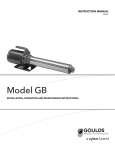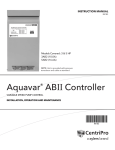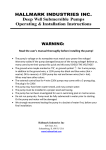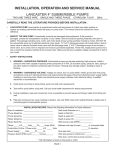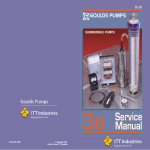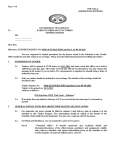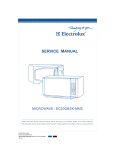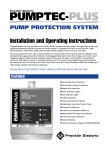Download 1Ø Service Manual Engineered for life
Transcript
GSSINGLE IT T Residential Water Systems 1Ø Service Manual • Submersible Pumps • Jet Pumps Goulds Pumps is a brand of ITT Corporation. www.goulds.com Engineered for life TABLE OF CONTENTS Table of Contents This manual covers single phase 4" submersible pumps and jet pumps. Submersibles: (Pages 1 – 35) Page Typical Systems....................................................... 1-3 Troubleshooting..................................................... 4-9 Amprobe Instructions.......................................... 10 Ohmmeter Instructions........................................ 11 A Capacitor Checkout.......................................... 12-13 B Relay Checkout.................................................. 14-16 C Overload Checkout.............................................. 17 D Voltage Checkout............................................. 18-19 E Electrical Short Checkout.................................. 20-21 F Motor Winding Resistance Checkout................. 22-23 G Cable Checkout................................................. 24-25 H Amperage Checkout......................................... 26-27 I Pressure Switch Adjustment............................... 28-29 J Pressure Tank Checkout...................................... 30-31 Submersible Pump Disassembly........................ 32-33 Submersible Pump Reassembly......................... 34-35 Jet Pumps: (Pages 36 – 71) Typical Systems..................................................... 36-41 Troubleshooting................................................... 42-49 1 Voltage Checkout.............................................. 50-51 2 Amperage Checks............................................. 52-53 Ohmmeter Checks............................................ 54-63 Wiring Diagrams............................................... 60-61 3 Checking Suction Lift........................................ 64-65 4 Pressure Control Valves..................................... 66-67 Jet Pump Disassembly....................................... 68-69 Jet Pump Reassembly........................................ 70-71 Goulds Pumps, CentriPro and the ITT Engineered Blocks symbol are registered trademarks and tradenames of ITT Corporation. Three-wire system illustrated using galvanized tank. RULE OF THUMB 1. 2. Use same size or larger pipe as discharge on pump. Always use a check valve for every 200 ft. of vertical pipe. Protected Power Supply Disconnect Switch Control Box Pressure Gauge To House Piping Shut-off Valve Union Drain Tap Pressure Relief Valve Air Escape Control Pressure Switch Pitless Adapter Drain and Y Fitting Line Check Valve with Snifter Union NOTE: Piping below the frost line is common in colder climate areas. In warm climates, the piping is often above ground and tank placement is often outside the house and/or inside a separate cover or housing. 1 SUBMERSIBLES Typical Submersible System . . . SUBMERSIBLES Typical Submersible System . . . Two-wire system illustrated; using diaphragm type tank. RULE OF THUMB 1. 2. Use same size or larger pipe as discharge on pump. Always use a check valve for every 200 ft. of vertical pipe. To House Piping Protected Power Supply Disconnect Switch Shut-off Valve Union Pressure Switch Pressure Relief Valve Drain Tap Pitless Adapter ➀ Check Valve ➀ Frost Level ➀ ➁ Tank Tee Check Valve ➁ On installations with a pitless adapter the top check valve should be below the pitless, not at the tank, as the discharge line should be pressurized back to the pitless. On installations with well seals or well pits it is allowable to locate the top check valve near the tank. CAUTION 2 All electrical equipment must be connected to supply ground. Follow applicable code requirements. TYPICAL SYSTEMS Three-wire Single Phase Wiring Diagram: L1 L2 Ground Breaker or Fuse Control Box L1 L2 B Y R Ground To Well Pressure Switch CAUTION All electrical equipment must be connected to supply ground. Follow applicable code requirements. 3 SUBMERSIBLES Troubleshooting INDEX An amprobe and ohmmeter are essential for properly checking a system. Use of the amprobe is explained on page 10. Use of the ohmmeter is explained on page 11. Find the basic problem . . . for which numerous symptoms are listed and possible solutions are given for each: Page ■ Pump Will Not Start.................................5 ■ Pump Will Not Run..................................6 ■ Pump Runs, But Little or No Water Delivered..................................7 ■ Insufficient Tank Pressure.........................8 ■ Pump Starts Too Frequently.....................9 RULE OF THUMB Remember, there may be other system problems caused by auxiliary controls not covered in this booklet. IMPORTANT This manual is intended ONLY for use by professionals familiar with NEC (National Electric Codes) electrical codes and hydraulic and safety procedures of pump installations. 4 Troubleshooting Pump Will Not Start . . . If fuses and overload check okay . . . PROBLEM: ANSWER: 1. No power or See D incorrect voltage 2. Defective pressure Inspect points and switch replace switch if necessary. 3. Loose connection See E, F, G in control box, cable or motor. 5 TROUBLESHOOTING Letters and Numbers in chart, ex. “See A” refer to sections in the Manual. Submersible sections use letters and Jet sections are numbered. SUBMERSIBLES Troubleshooting Pump Will Not Run . . . If motor overload trips or fuses blow . . . PROBLEM: ANSWER: 1.Improper size fuses Replace with correct. 2.Wrong control box Replace with correct. 3.Incorrect voltage See D 4.Defective control box See A, B, C 5.Loose connections See E in control box, Condition causes cable or motor improper resistance readings. 6.Cable insulation See G damaged or splice Condition causes may be open or improper resistance shorted readings. 7.Defective pressure Inspect points and/ switch or or replace switch if plugged tubing necessary. 8.Control box in hot Temperature not to environment exceed 122°F (50°C). 9.Pump bound by Pull pump and abrasives clean. See H Condition causes high amperage. 6 Pump Runs, But . . . Little or no water delivered . . . PROBLEM: ANSWER: 1.Line check valve stuck Replace if defective. or installed backwards 2.Connections loose See wiring diagram or misconnected in in control box. control box 3.Incorrect voltage See D 4.Pump not submerged Check water level in well. 5.Leak in piping system Replace if necessary. 6.Worn pump Repair or replace water-end. 7.Worn motor Replace motor. 8.Suction screen or Pull pump and impeller clogged clean. 9.Broken pump shaft Replace. or coupling 7 TROUBLESHOOTING Troubleshooting SUBMERSIBLES Troubleshooting Insufficient Tank Pressure . . . PROBLEM: 1. Improper pressure switch setting 2. Incorrect voltage 3. Excessive pump wear 4. Leaks in piping system 8 ANSWER: See I See D Repair or replace. Repair or replace. Repair or replace. Pump Starts Too Frequently . . . PROBLEM: ANSWER: 1.Waterlogged tank a. Galvanized Check tank for leaks. Check drain and “Y” fittings, snifter valve for proper operation. b. Captive air type See J 2.Check valve Replace if necessary. stuck open 3.Improper pressure See I switch setting 4.Leaks in Repair or replace piping system 5.Pressure tank improperly sized RULE OF THUMB Must be sized to allow a minimum run time per cycle as follows: 1 ⁄3 – 1½ HP = 1 minute run time 2 HP & larger = 2 minute run time 9 TROUBLESHOOTING Troubleshooting SUBMERSIBLES Amprobe Instructions The Amprobe is a multi-range, combination ammeter and voltmeter. Voltmeter Scales: 150 VOLTS 600 VOLTS Ammeter Scales: 5 AMPS 40 AMPS 15 AMPS 100 AMPS 1.When used as an ammeter, the tongs are placed around the wire being measured with the rotary scale on the 100 amp range. Then rotate the scale back to the smaller ranges until an exact reading is indicated. 2.When used as a voltmeter, the two leads are clipped into the bottom of the instrument with the rotary scale on the 600 volt range. If the reading is less than 150 volts, rotate the scale to the 150 volt range to get a more exact reading. 10 The Ohmmeter is used for measuring the electrical resistance of a wire circuit. The unit of measurement is called an Ohm. 1.The knob at the bottom of the Ohmmeter is adjustable through six ranges: RX1 = R x 1 If your ohmmeter RX10 = R x 10 is digital readout RX100 = R x 100 type, refer to the RX1000 = R x 1,000 instructions that RX10K = R x 10,000 came with it. RX100K = R x 100,000 2. The round center knob is for the purpose of adjusting the instrument to zero (0) after clipping the two ohmmeter leads together. This must be done every time the range selection is changed. CAUTION Use Ohmmeter only with power off. 11 AMPROBE/OHMMETER INSTRUCTIONS Ohmmeter Instructions SUBMERSIBLES A Capacitor Checkout Capacitor with Ohmmeter CAUTION Discharge the capacitor before making this check. (A screwdriver can be used to make contact between capacitor’s posts.) 1.Disconnect leads to capacitor post. 2.Setting: R x 1,000 3.Connect ohmmeter leads to capacitor posts. 4.Reading: Pointer should swing toward zero, then back toward infinity. 12 Capacitor Checkout A. CAPACITOR CHECKOUT A “Quick-Disconnect” Control Box RULE OF THUMB To recheck, reverse the OHMMETER LEADS. 13 SUBMERSIBLES B Relay Checkout Voltage Relay Control Boxes (CentriPro or F.E.) Checking Relay with Ohmmeter A. Voltage Relay ½ – 1 HP CP - QD; 1 – 15 HP CSCR Control Boxes Step 1, Coil Test 1. Meter setting: R x 1,000. 2. Connections: #2 & #5. 3. Correct meter readings: For 115 Volt Boxes: .7 – 1.8 (700 to 1,800 ohms). For 230 Volt Boxes 4.5 – 7.0 (4,500 to 7,000 ohms). Step 2, Contact Test 1. Meter setting: R x 1. 2. Connections: #1 & #2. 3. Correct meter reading: Zero for all models. 14 C. F.E. Black Solid State Switch 1 ⁄3 – 1 HP QD Control Boxes Used from 1985 until 1994 Step 1, Triac Test Step 2, Coil Test 1. Meter setting: 1. Meter setting: R x 1,000. R x 1. 2. Connections: 2. Connections: R (Start) terminal Y (Common) and orange lead and L2. on start switch. 3. Correct meter 3. Correct meter reading: Zero reading: Infinity ohms for all for all models. models. 15 B. SINGLE PHASE CONTROL BOX RELAY CHECKOUT B. F.E. Blue Relay - Solid State 1 ⁄3 – 1 HP QD Control Boxes Used from 1994 until present time: Step 1, Triac Test Step 2, Coil Test 1.Meter setting: 1. Meter setting: R x 1,000. R x 1. 2.Connections: Cap 2. Connections: and B terminal. L1 and B. 3.Correct meter 3. Correct meter reading: Infinity reading: Zero for all models. ohms for all models. SUBMERSIBLES B Relay Checkout Continued Contactor Checkout Checkout procedure for magnetic and other Contactors Contactor Coil Test (Disconnect lead from one side of coil) 1. Meter setting: R X 100 2. Connections: Coil terminals 3. Correct meter reading: 180 to 1,400 ohms Contactor Contact Test 1. Meter Setting: R X 1 2. Connections: L1 & T1 or L2 & T2 3. Manually close contacts 4. Correct meter reading: Zero ohms Additional information on troubleshooting and replacement parts for Single Phase Control Boxes is available in the ITT, MAID; Motor Application, Installation Manual and in the F.E. AIM. It is available online at www.goulds.com and www.franklin-electric.com. 16 Overload Checkout . . . For 1½ HP (and Larger) Control Box . . . 1.Set Ohmmeter at “R x 1” 2.Connect the Ohmmeter leads to Terminal #1 and #3 on each Overload Protector. 3.Reading should be not more than 0.5 Ohms maximum on the scale. CSCR or Mag. Contactor Control Box 17 C. CONTROL BOX OVERLOAD CHECKOUT C SUBMERSIBLES D Voltage Checkout To Check Voltage with “Q.D.” Type Control Box 1.Remove cover to break all motor connections. CAUTION L1 and L2 are still connected to power. 2.To check VOLTAGE: Use voltmeter on L1 and L2 as shown. 3.When checking voltage, all other major electrical appliances (that could be in use at the same time) should be running. 4.If readings are not within the limits (see chart), call your power supplier. 18 Voltage Limits Measured Volts Nameplate ▼ Min. Max. 115V 1ø 105 125 208V 1ø 188 228 230V 1ø 210 250 Voltage Checkout D. VOLTAGE CHECKOUT D 19 SUBMERSIBLES E Electrical Short Checkout . . . Measuring Insulation Resistance 1.Set the scale lever to R x 100K and adjust to 0. CAUTION Open (turn off) master breaker and disconnect all leads from control box or pressure switch (Q-D type control, remove lid) to avoid damage to meter or electric shock hazard. 2.Connect an ohmmeter lead to any one of the motor leads and the other to the metal drop pipe. If the drop pipe is plastic, connect the ohmmeter lead to the metal well casing or ground wire. OHMS R x 100K Drop Cable with Ground Wire 20 R x 100 R x 10 Rx1 ZERO OHMS R x 1000 R x 10K R x 100K Insulation resistance does not vary with rating. All motors of all HP, voltage and phase rating have similar values of insulation resistance. Condition of Motor and Leads Ohm Megohm Value Value A new motor (without drop cable). 20,000,000 20.0 (or more) A used motor which can be 10,000,000 10.0 reinstalled in the well. (or more) Motor in Well. Ohm readings are 2,000,000 2.0 for drop cable plus motor. (or more) A new motor in the well. A motor in the well in reasonably 500,000 – good condition. 2,000,000 0.5 – 2.0 A motor which may have been damaged 20,000 – 0.02 – 0.5 by lightning or with damaged leads. Do 500,000 not pull the pump for this reason. A motor which definitely has been 10,000 – 0.01 – damaged or with damaged cable. The 20,000 0.02 pump should be pulled and repairs made to the cable or the motor replaced. The motor will not fail for this reason alone, but it will probably not operate for long. A motor which has failed or with Less than 0 – 0.01 completely destroyed cable insulation. The 10,000 pump must be pulled and the cable repaired or the motor replaced. What It Means 1. If the ohm value is normal, the motor windings are not grounded and the cable insulation is not damaged. 2. If the ohm value is below normal, either the windings are grounded or the cable insulation is damaged. Check the cable at the well seal as the insulation is sometimes damaged by being pinched. Winding Resistance Measuring When measured as shown on page 22, motor resistance only should fall within the values in Table 3, page 23. When measured through the drop cable, the size and length of the cable must be known and the correct cable resistance from Table 2 subtracted from the ohmmeter reading to get the winding resistance for comparison with Table 3. 21 E. ELECTRICAL SHORT CHECKOUT Table 1 Normal Ohm and Megohm Values (Insulation Resistance) Between All Leads and Ground SUBMERSIBLES F Motor Winding Resistance Checkout . . . Measuring Winding Resistance 1.Set the scale lever to R x 1 for values under 10 ohms. For values over 10 ohms, set the scale lever to R x 10. Zero balance the ohmmeter as described earlier on page 11. CAUTION Open master breaker and disconnect all leads from control box to pressure switch (Q-D type control, remove lid) to avoid damage to meter or electric shock hazard. 2.Connect the ohmmeter leads as shown below. Table 2 Cable Resistance – Copper Size Cable 14 12 10 8 6 4 2 DC Resistance of Cable per 100 Foot Length Ohms per Pair of Leads .544 .338 .214 .135 .082 .052 .032 If aluminum cable is used the readings will be higher. Divide the ohm readings on this chart by 0.61 to determine the actual resistance of aluminum cable. 22 Ground Wire OHMS R x 100 R x 10 Rx1 Motor Leads ZERO OHMS R x 1000 R x 10K R x 100K Rx1 or R x 10 Single Phase Motors – Winding Resistance Motor Only (Ohms) 4" Motors CentriPro Franklin Electric Winding KVA Winding KVA Type HP Volts Resistance Code Resistance Code ½ 115 1.3-1.8 K 1.0-1.3 R ½ 230 4.5-5.2 K 4.2-5.2 R 2-Wire ¾ 230 3.0-4.8 J 3.0-3.6 N (PSC) 1 230 4.2-5.2 F 2.2-2.7 N 1½ 230 1.9-2.3 H 1.5-1.9 M 4" Motors CentriPro Franklin Electric Resistance Resistance KVA KVA Type HP Volts Main Start Code Main Start Code (B-Y) (R-Y) (B-Y) (R-Y) 3-Wire ½ .9-1.6 5.7-7.0 N 1.0-1.3 4.1-5.1 M 4.2-4.9 17.4-18.7 M 4.2-5.216.7-20.5 M w/Q.D. ½ 115 Cap. ¾ 2.6-3.6 11.8-13 L 3.0-3.610.7-13.1 M Start 1 2.2-3.2 11.3-12.3 L 2.2-2.7 9.9-12.1 L J 1.7-2.2 8.0-9.7 J 3-Wire 1½ 1.6-2.3 7.9-8.7 w/CSCR 2 1.6-2.2 10.8-12.0 G 1.8-2.3 5.8-7.2 G 230 (CR) G 1.0-1.5 3.5-4.4 H Control 3 1.1-1.4 2.0-2.5 5 .62-.76 1.36-1.66 E .68-1.0 1.8-2.2 F Box 6" Motors CentriProFranklin Electric Resistance KVA Resistance KVA Type HP Volts R - Y B - Y R - B Code (B-Y) (R-Y) Code 5 2.1720.5122.627 G .55-.68 1.3-1.7 E 6" F Single 7.5 230 1.401 0.4 1.774 F .36-.50 .88-1.1 Phase 10 1.0520.316 1.31 E .27-.33 .80-.99 E 15 0.678 0.23 0.85 D .17-.22 .68-.93 E RULE OF THUMB Add resistance of drop cable when checking pump in well. See Table 2 page 22. What it Means 1. 2. 3. 4. If all ohm values are normal, the motor windings are neither shorted nor open, and the cable colors are correct. If any one ohm value is less than normal, the motor is shorted. If any one ohm value is greater than normal, the winding or the cable is open or there is a poor cable joint or connection. If some ohm values are greater than normal and some less, the leads are mixed. 23 F. MOTOR WINDING RESISTANCE CHECKOUT Table 3 Motor Resistance SUBMERSIBLES G Cable Checkout . . . Checking Cable and Splice 1.Submerge cable and splice in steel barrel of water with both ends out of water. 2.Set ohmmeter selector on RX100K and adjust needle to zero (0) by clipping ohmmeter leads together. 3.After adjusting ohmmeter, clip one ohmmeter lead to barrel and the other to each cable lead individually, as shown. 4.If the needle deflects to zero (0) on any of the cable leads, pull the splice up out of the water. If the needle falls back to (∞) (no reading) the leak is in the splice. 5.If leak is not in the splice, pull the cable out of the water slowly until needle falls back to (∞) (no reading). When the needle falls back, the leak is at that point. 6.If the cable or splice is bad, it should be repaired or replaced. 24 G. CABLE CHECKOUT Checking Cable and Splice Test OHMS Ohmmeter Set at R x 100K R x 100 R x 10 Rx1 ZERO OHMS R x 1000 R x 10K R x 100K Attach this lead to Metal Tank 25 SUBMERSIBLES H Amperage Checkout . . . Service Factor Amps w/QD (½ - 1 HP) or CSCR (1.5 HP & larger) Control Boxes 4" CP F.E. CP F.E. 1Ø 3-Wire 3-Wire 2-Wire2-Wire HP Volts Yel Black Red Yel Black Red Black Black ½ 115 12.6 12.6 0 12.0 12.0 0 9.5 12.0 ½ 6.3 6.3 0 6.0 6.0 0 4.7 6.0 ¾ 8.3 8.3 0 8.0 8.0 0 6.4 8.0 1 9.7 9.7 0 9.8 9.8 0 9.1 9.8 1½ 230 11.1 11.0 1.3 11.5 11.0 1.3 11.0 13.1 2 12.2 11.7 2.6 13.2 11.9 2.6 3 16.5 13.9 5.6 17.0 12.6 6.0 N/A 5 27.0 22.0 10.027.5 19.1 10.8 Service Factor Amps w/Magnetic Contactor Control Boxes 6" Single Phase CentriPro 3-Wire Franklin Elec 3-Wire HP Volts Yel Black Red Yel Black Red 5 27.5 N/A N/A 27.5 17.4 10.5 7.5 41.0 N/A N/A 42.1 40.5 5.4 230 10 58.0 N/A N/A 51.0 47.5 8.9 15 85.0 N/A N/A 75.0 62.5 16.9 26 H. AMPERAGE CHECKOUT Control Box With Cover Attached Control Box With Cover Attached Ground To Power Supply Amprobe Meter set on Ampere Scale 27 SUBMERSIBLES I Pressure Switch Adjustment Checkout . . . CentriPro and Square D AS3 AS4 Adjust in Proper Sequence: 1.CUT-IN: Turn range nut (big Spring) down for higher cut-in pressure, or up for lower cut-in. 2.CUT-OUT: Turn differential nut (small spring) down for high cut-out pressure, or up for lower cut-out. CAUTION To avoid damage, do not exceed maximum allowable system pressure. Check switch operation after resetting. Max. Square D pressure 65 PSI, Max. CentriPro pressure 80 PSI. 28 I. PRESSURE SWITCH ADJUSTMENT FURNAS 1.MAIN SPRING ADJUSTMENT: Turn clockwise to increase both Cut-Out and Cut-In pressure. (2 PSI/turn). 2.DIFFERENTIAL ADJUSTMENT: Turn differential nut clockwise to increase Cut-Out pressure without affecting Cut-In (3 PSI/turn). CAUTION (FURNAS) To avoid damage, do not exceed maximum allowable system pressure. Check switch operation after resetting. Maximum pressure 80 PSI. 29 SUBMERSIBLES J Pressure Tank Checkout Procedure . . . 1.To check: Shut off power supply and drain system to “0” pressure. 2.Air pre-charge in tank should be 2 psi less than the cut-in pressure of the pressure switch. Example: If pressure switch setting is 30-50 psi, tank should be pre-charged with 28 lbs. air. 3.If water at valve, replace tank. RULE OF THUMB Improper tank sizing may cause motor damage. ½ to 1½ HP pumps – Tank draw down should be equal to the pump capacity in GPM or greater. Example: ¾ HP pump; capacity 12 GPM; pressure switch setting 30/50 PSI; correct tank – V140. 2 HP and larger pumps – tank drawdown should be double the pump capacity in GPM. Example: 3 HP pump; capacity 30 GPM; pressure switch setting 40/60 PSI; correct tank selection: 2 – V350 tanks. 30 J. PRESSURE TANK CHECKOUT PROCEDURE Shown with base extension 31 SUBMERSIBLES Repair or Replace – Some Considerations – While our pumps are designed for ease of repair it is important to compare the cost of repair versus the cost of water end replacement. Replacing typical wear parts such as impellers and diffusers is a cost effective choice. However, if the outside metal parts such as the casing, motor adapter and discharge head all require replacement due to extremely harsh water it may be less expensive to simply purchase a complete new water end. A new casing or discharge head will require drilling and tapping for two new cable guard holes. Pump Disassembly for Typical 4" Submersible Pumps... 1. Remove 4 cable guard screws and remove cable guard. 2. Reinstall top 2 screws so that discharge head and casing may be removed as one piece. 3. 32 Using two pipe wrenches or a vice and pipe wrench, hold the motor adapter and turn the discharge head/ casing assembly clockwise (it has left-hand threads) to loosen the assembly. 33 PUMP DISASSEMBLY 4. Remove the casing assembly to expose the stages. 5. Remove the klip ring from the top of the shaft, this will allow you to remove the stages from the shaft. Note that on units which have operated in sandy water it may be hard to disassemble the stages. 6. The complete stages should be removed one at a time, disassembled and inspected. Replace worn parts as needed. 7. On most models the shaft and coupling assembly is replaceable without removing the motor adapter. Lift the shaft off and inspect the coupling and motor splines for excessive wear. 8. If motor replacement is necessary, remove the 4 nuts from the motor studs and separate the motor and motor adapter. If motor is OK, leave assembly intact. 9. The shaft sleeve is now part of the shaft/coupling assembly and will not have to be ordered as a replacement part. Shaft couplings are not available alone as they are a pressed part. Replace the entire shaft/coupling assembly if either shows wear. 10. We use several check valve styles. Some are built-in and some screw in from the top (outside) of the discharge head. Replace as necessary. Replacement of a “GS” check valve will require separation of the discharge head and casing as it installs from inside the discharge head. You may also replace it using a standard screw-in line type check valve. SUBMERSIBLES Pump Reassembly . . . 1. 2. 3. 4. 5. 6. 34 Clean all parts including the strainer. Replace basket type internal strainer now. Place shaft and coupling assembly (and spacer where used) onto motor spline. Reattach the motor adapter to the motor. Tighten the nuts in an alternating pattern. Place straight edge across the rim of motor adapter. If it fails to touch the shaft sleeve, add one or more .010" shims (repair part No. 7K155) until they are either flush with motor adapter or slightly high, never low. Install first stage bowl, first stage impeller, and diffuser. Stack-up of the impeller hubs is checked by straight edge. Install succeeding stages in the same manner as the first. Check stack-up at least every second or third stage. If straight edge laid across the diffuser face fails to contact the impeller hub, a shim should be added (underneath the impeller). This will keep the bottom of the impeller from dragging on the bowl. Longer units have one intermediate bearing spider and sleeve, which should be placed to divide the stages evenly. 35 PUMP REASSEMBLY 7. When all stages are in place, replace klip ring on shaft. 8. Check upper bearing for wear and replace if loose on shaft. Replace bearing spider on stack. 9. Replace casing/discharge head assembly, turning counterclockwise (left-hand threads). Turn it all the way down so that the casing bottoms against the flange on the motor adapter. 10. Using a pipe wrench on the motor adapter and one on the discharge head, tighten to approximately 85 lbs/ft. This will be approximately 1⁄8 to ¼ turn from the hand tight position. 11. Remove the upper cable guard screws and replace the cable guard using all 4 screws. The cable guard should be straight up and down if the casing is properly tightened. 12. If you installed a new casing or discharge head they will have to be drilled and tapped to provide holes for the cable guard screws. Use a 9⁄64" drill and an 8-32 NC tap. 13. Replace the external wrap around strainer where used. New part number is 7K2242. JET PUMPS Jet Pumps . . . Since these are the basic types that have been used for many years, the vast majority of jet pump service work will be on these types . . . Horizontal Jet J+ 36 JET PUMPS Vertical Jet SJ 37 JET PUMPS Typical Jet Pump System . . . Shallow Well System illustrated is a Convertible jet pump with a shallow well adapter and a pressure tank. RULES OF THUMB • All jet pumps should be located at the highest point in the suction side of the system. • (Distance from well head to pump) If offset is greater than 20' . . . increase horizontal pipes by one size each. • Never use pipes smaller than the pump suction tappings. 38 TYPICAL JET PUMP SYSTEMS 39 JET PUMPS Typical Jet Pump System . . . Deep Well Packer and twin pipe systems 40 TYPICAL JET PUMP SYSTEMS Improper Installations • Trap air • Hard to prime TRAPS AIR Proper Installations • Easy to prime 41 JET PUMPS Troubleshooting INDEX An amprobe, ohmmeter and vacuum pressure gauge are essential for properly checking a system. Use of the amprobe is explained on page 10. Use of the ohmmeter is explained on page 11. Use of the compound vacuum pressure gauge is explained on page 66. Find the basic problem . . . for which numerous symptoms are listed and possible solutions are given for each: Page ■ Pump Will Not Run................................... 43 ■ Pump Runs, But Little or No Water Delivered.............................................. 44-45 ■ Pump Starts and Stops Too Often....... 46-47 ■ Insufficient Tank Pressure......................... 48 ■ Switch Does Not Cut Out......................... 49 RULE OF THUMB Remember there may be other system problems caused by auxiliary controls not covered in this booklet. 42 Pump Will Not Run . . . PROBLEM: 1. Blown fuse or power turned off 2. Broken or loose wiring connections. 3. Motor overload protection contacts open. a. Improper voltage. b. Pump bound mechanically – will not turn freely. 4. Pressure switch faulty or out of adjustment. 5. Tubing or fittings on pressure switch plugged. 6. Faulty motor. ANSWER: Replace fuse – close all switches. Examine all wiring and repair any bad connections. Overload contacts will close automatically in a short time. See 1 Volt Ammeter Remove motor end cap, turn motor shaft by hand. Unit should rotate freely. Adjust or replace switch. See I. Remove switch tubing and/or all fittings and clean. See 2 43 TROUBLESHOOTING Troubleshooting JET PUMPS Troubleshooting Pump Runs But . . . Little or no water delivered . . . PROBLEM: ANSWER: 1. Pump or pipes not Fill pump completely primed. completely with water through priming opening (reprime pump). a. Deep Well system Control valve must be set properly or system will not pump. See 4 2. Foot valve or end of a. Shallow Well suction pipe either not system Install submerged or buried. vacuum gauge See 3 b. Deep Well system Physically check well conditions. Foot valve in well or Replace foot valve if line check valve stuck necessary. (Very closed. high vacuum, 22 inches or more, see 3. 3. Leaks on suction side Pressurize system of pump. (Very and inspect. common problem.) 44 Pump Runs But . . . PROBLEM: 4.Jet assembly plugged. 5.Punctured diaphragm in air control. Galvanized tanks. 6.Original installation, incorrect nozzle or diffuser combination. ANSWER: A. Shallow Well system Clean if necessary. (Insert wire through ½" plug in shallow well adapter.) b. Deep Well system Pull jet assembly and clean. Disconnect the tubing and plug the connection in pump. If this corrects the trouble, the air control must be replaced. Check rating in product catalog. 45 TROUBLESHOOTING Troubleshooting JET PUMPS Troubleshooting Pump Runs But . . . Pump starts and stops too often . . . POSSIBLE CAUSE: ANSWER: 1.Leaks in piping system. Pressurize piping system and inspect. Repair or replace. 2.Faulty pressure switch. Check contact points. Adjust or replace switch. See I 3.Waterlogged Pumps using Brady galvanized tank, control: Test by faulty air control. holding your ear on air control. If control is operating, air can be heard passing from control into tank when pump stops. If no air movement is heard, air control should be replaced. 4.Leaking tank or Use soapy water to air valve. find leaks. Repair or replace. 46 Pump Runs But . . . POSSIBLE CAUSE: ANSWER: 5.Not enough suction Throttle suction line lift on shallow well with partially closed system – water flows valve. into pump (flooded suction). 6.Insufficient vacuum or Pump requires vacuum does not exist minimum 3" for long enough time vacuum for to operate air control. 15 seconds. 7.Improper air change See J in in captive air tank. submersible section. 8.Tank too small Replace with for pump. proper size storage tank. 47 TROUBLESHOOTING Troubleshooting JET PUMPS Troubleshooting Pump Runs But . . . Pumps water, but does not develop 40 lbs. tank pressure. . . PROBLEM: ANSWER: 1.Leaks in well piping Pressurize piping or discharge pipe. system and inspect. 2.Jet or screen on foot Clean if necessary. valve partially plugged. 3.Improper pressure See 4 control valve setting (deep well only). 4.Suction lift too high Use vacuum gauge for shallow well on shallow well system. systems. Vacuum should not exceed 22 inches at sea level. a. Jet set too deep for On deep well system deep well system. check ratings tables in catalog for maximum jet depth. 5. Faulty air charger. Disconnect the tubing and plug the hole. If this corrects the trouble, the air control must be replaced. 6.Worn impeller hub Replace if necessary. and/or guide vane Clearance should not bore. exceed .012 on a side or .025 diametrically. 7.Overpumping the well. Throttle a valve on the pump suction – do not exceed 22" Hg. 48 Pump Runs But . . . Pump develops 40 lbs. pressure, but switch does not cut out . . . PROBLEM: ANSWER: 1.Pressure switch See I in incorrectly set. submersible section. 2.Tubing or fittings Remove switch between switch and tubing and/or all pump plugged. fittings and clean. 3.Faulty switch or Replace if necessary. corroded contact points. 49 TROUBLESHOOTING Troubleshooting JET PUMPS 1 How to Use Volt-Ammeter For Voltage Check CAUTION Power is ON during voltage checking. 1.Attach leads to volt-ammeter and select proper voltage scale for voltage to be tested. 2.Place leads in A position to test for presence of incoming voltage. • Voltage should be within + 10% of the design voltage specified on the motor nameplate in A, B and C test positions. 3.With disconnect switch in ON position, move leads to B position and test voltage flow through fuse(s). 4.The C position tests voltage at pressure switch terminals. The voltage should be within limits with the motor operating. Voltage Limits Nameplate ▼ Measured Volts Min. Max. 115V 1ø 105 125 208V 1ø 188 228 230V 1ø 210 250 50 1. HOW TO USE VOLT AMMETER 51 JET PUMPS 2 How to Check Amperage 1.If attached, remove leads from volt- ammeter. Select lowest reading amperage scale according to motor nameplate rating. 2.With disconnect switch in OFF position, clamp instrument around one incoming lead at pressure switch. •Turn switch ON and observe amperage as motor runs. With proper voltage, reading should not exceed the MAXIMUM LOAD AMPERAGE of motor. •Excessive amps means an overloaded condition or incorrect voltage applied. Problem could also be in motor. •Take readings with pump running at normal system pressure. At open discharge (zero pressure) the pump may exceed maximum amps due to no discharge head. 52 2. HOW TO CHECK AMPERAGE AT PRESSURE SWITCH CAUTION Power is ON during amperage testing. 53 JET PUMPS 2 Ohmmeter Checks . . . CAUTION Use ohmmeter only with POWER OFF. Power supply OFF. Disconnect motor leads (L1 and L2). On dual-voltage motors, motor must be wired 230V for the checks listed below and illustrated on the page indicated for each check. Rewire for 230V if necessary. CHECK: Page a.Ground..................................................... 55 b.Winding Continuity.............................56-57 c. Contact Points (Switch).......................58-59 d.Overload Protector..............................60-61 e.Capacitor.............................................62-63 54 Ground Check . . . CAUTION Disconnect Power Source before checking. a.Set ohmmeter to R x 1,000. b.Attach one probe to ground screw and touch other probe to all terminals on terminal board, switch, capacitor and protector – any ohmmeter reading indicates ground. If digital meter is used, the reading should be at least one megohm. c. If grounded, check all external leads for cuts, breaks, frayed wires, etc. Replace damaged leads and recheck for grounds and proper lead routings. Make sure replaced leads are not pinched between canopy and end bell. If ground is in stator, replacement of motor is recommended. 55 2. OHMMETER CHECKS a JET PUMPS 2 Ohmmeter Checks . . . b Winding Continuity . . . CAUTION Disconnect Power Source before checking. 1.Terminal board connected for 230 V. 2.Set ohmmeter to R x 1, adjust to 0. 3.Slip a heavy piece of paper between motor switch points, discharge the capacitor and take the following ohm readings: a.Resistance between L1 and A must be the same as between A and yellow. b.Yellow to red (winding side of switch) must be the same as L1 to same red terminal. OVERLOAD PROTECTOR GOVERNOR 115/230 VOLT VOLTAGE SELECTOR SWITCH START CAPACITOR PRESSURE SWITCH WIRING TERMINAL BOARD START SWITCH L1 = Blue wire L2 = White wire A = Purple wire 56 Old Style (Brown) Terminal Board Wiring. A.O. SMITH MOTOR WIRING 115 VOLT 230 VOLT Black (from motor) Black (from motor) on L1 on A Black/White (Black tracer from overload) on A Black/White (Black tracer from overload) on B 57 2. OHMMETER CHECKS – AO SMITH MOTORS Ohmmeter tests on the new style terminal board with the quick-change voltage terminal plug, see picture on pg. 60 (Black plastic part with 2 wires in it) is simplified if your ohmmeter is equipped with the sharp, pointed probes rather than alligator clips. With the voltage change plug on the 230 volt terminal the Black wire in the plug is positioned on Terminal “A”. Simply touch one ohmmeter probe on the Black wire in the voltage change plug to get the “A” terminal reading. Another method is to remove the terminal board screws and place the alligator clip on the wire on the bottom side of Terminal “A”. JET PUMPS 2 Ohmmeter Checks . . . c Contact Points (switch) . . . CAUTION Disconnect Power Source before checking. 1.Set ohmmeter to R x 1, adjust to 0. 2.Remove leads from switch. 3.Attach ohmmeter leads to each side of switch – reading should be 0. 4.Flip governor weight to run position. Reading should be infinity. 2 Ohmmeter Checks . . . d AO Smith Motor Overload Protector . . . CAUTION Disconnect Power Source before checking. 1.Set ohmmeter to R x 1, adjust to 0. 2.Disconnect the overload leads. 3.Check resistance between terminals 1 and 2, then 2 and 3. If either reading is higher than 1, replace the overload. 1 = Blue wire 2 = Black/white wire 3 = Yellow wire 58 2. OHMMETER CHECKS AO SMITH MOTORS 59 WHITE STATOR LEADS PURPLE BLACK BLACK TRACER YELLOW BLUE 2 3 1 PLUG 115 230 JET PUMPS Motor Terminal Board and Voltage Change Plug A L1 YELLOW RED RED TRACER “Black Tracer” is a black and white wire 60 L2 LINE LEADS MOTOR WIRING Motor Terminal Board and Voltage Change Wiring (old style – up to april, 1999) YELLOW RED PHASE MAIN YELLOW RED BLACK 1 2 3 L2 BLACK TRACER L2 B 230 V A PURPLE L1 MAIN L1 WHITE “Black Tracer” is a black and white wire BLACK TRACER L2 115 V A BLACK L1 61 AO SMITH MOTORS B TO WIRE FOR 230 V: BLACK TRACER TO B BLACK TO A TO WIRE FOR 115 V: BLACK TRACER TO A BLACK TO L1 JET PUMPS 2 Ohmmeter Checks . . . e Capacitor . . . CAUTION Disconnect Power Source before checking. IMPORTANT Discharge capacitor by touching the two terminals with the blade of an insulated handle screwdriver. 62 2. OHMMETER CHECKS 63 ALL MOTORS 1.Set ohmmeter to R x 1,000, adjust to 0. 2.Disconnect leads on capacitor. 3.Attach ohmmeter leads to each terminal. Needle should swing to right and drift slowly to left. To double check, switch ohmmeter leads and repeat procedure. If the needle will not move or moves toward 0 and stays there, the capacitor is bad. 4.If a digital meter is used, readings should start low and rapidly increase to maximum value. JET PUMPS 3 Checking Suction Lift . . . A vacuum gauge indicates total suction lift (vertical lift + friction loss = total lift) in inches of mercury. 1" on the gauge = 1.13 ft. of total suction lift (based on pump located at sea level). RULE OF THUMB Practical suction lift at sea level is 25 ft. Deduct 1 ft. of suction lift for each 1,000 ft. of elevation above sea level. Shallow Well System Install vacuum gauge in shallow well adapter. See opposite page. When pump is running, the gauge will show no vacuum if the end of suction pipe is not submerged or there is a suction leak. If the gauge shows a very high vacuum (22 inches or more), this indicates that the end of suction pipe is buried in mud, the foot valve or check valve is stuck closed or the suction lift exceeds capability of pump. High Vacuum (22 inches or more) • Suction pipe end buried in mud • Foot valve or check valve stuck closed • Suction lift exceeds capability of the pump Low Vacuum (or 0 vacuum) • Suction pipe not submerged • Suction leak 64 A reading of 20" on a vacuum gauge placed on the suction side of the pump would tell you that you have a vacuum or suction lift of 22.6 ft. 20" x 1.13' = 22.6 ft. Vacuum Gauge 22.6' Vertical Lift Plus Friction 65 3. CHECKING SUCTION LIFT Compound Vacuum Pressure Gauge This gauge will show the pressure or vacuum at any position in a pump or system where it is installed. JET PUMPS 4 Pressure Control Valves . . . When pump is first started or under maximum flow condition, pressure control should be immediately adjusted to the pressure corresponding to H.P. and jet assembly used. See rating tables in catalog for proper pressure setting. 1.Turn left to reduce pressure. 2.Turn right to increase pressure. RULE OF THUMB If pressure control valve is set too high, the air volume control will not function. If pressure control valve is set too low, the pump may not shut off. To Adjust Pressure Control Valve: 1.Close pressure control valve. 2.Open faucet in house. 3.Turn pump on. 4.As pump picks up its prime, the pressure will begin to rise on the gauge. 5.Turn adjusting screw to set pressure control valve to pressure recommended in catalog. 66 Use with ½ and ¾ HP pumps requiring control valve settings up to 35 PSI. Use with pumps requiring 35 PSI or higher control valve setting: Typically all multi-stage units and single-stage pumps 1 HP and larger. AV21 Use with deep well multi-stage and high pressure units. 67 4. PRESSURE CONTROL VALVES AV15 JET PUMPS Jet Pump Disassembly . . . 1. Turn off power to motor. Disconnect service wires from pressure switch. 2. Drain system to relieve pressure. 3. Disconnect motor cord from pressure switch when used. 4. Remove casing bolts. If pump is mounted on top of tank, remove bolt holding motor adapter to mounting pad. 5. Disconnect tubing between casing or pressure control valve and pressure switch. 6. Remove motor, motor adapter casing, and rotating element. Casing remains attached to piping. 7. Remove guide vane seal ring and diaphragm gasket ring. 8. Remove guide vane from motor adapter (via 4 bolts or may be snap in type). 9. A.O. Smith Motors – Remove motor end cover. Insert 7⁄16" open end wrench under switch mechanism or behind overload protector onto flats on motor shaft. While holding the shaft against rotating, turn the impeller counterclockwise. The impeller should turn completely off the shaft in this manner. 10.Using two screwdrivers, pry out holding collar of mechanical seal assembly. 11.Motor adapter can be unbolted from the motor (for motor replacement). 68 JET PUMP DISASSEMBLY 69 JET PUMPS Jet Pump Reassembly . . . 1. 2. 3. 4. 5. 6. 7. 70 Be sure that recess for seal seat and surface where guide vane mounts on motor adapter are entirely free of all scale and dirt. Clean motor shaft. Apply film of light oil, such as vegetable oil, to the recess of the motor adapter and the neoprene bushing before installing the new seal seat. This is a tight fit, but it must go in all the way evenly, or a leak will result. Do not mar lapped face of this seal. The slightest scar or particle of dirt will cause a leak. Bolt motor adapter to motor, making sure the motor shaft does not dislocate the stationary seal member. Assemble rotating member of seal on motor shaft. Rotating seal face must fit snugly against lapped seal face of stationary member in casing cover. This is accomplished by pushing with a piece of tube against back end of neoprene washer after oiling sleeve and shaft. Be sure rotating seal face does not drop out of holding collar while sliding the rotating members of the seal on the shaft. Also, take extra care that the rotating seal face is not marred during handling. While holding the shaft against rotating, screw impeller on shaft by hand until tight against shoulder of motor shaft. Replace guide vane, making sure that bore of guide vane does not bind impeller hub. If screws used, tighten alternately and evenly. Check by turning the motor shaft. If binding occurs, loosen screws, readjust guide vane until impeller hub turns freely, then tighten screws as before. Some jets have snap-in guide vane. JET PUMP REASSEMBLY 8. Replace diaphragm gasket with opening in the upper position. 9. Replace guide vane seal ring on guide vane hub. 10.Make sure all gasket surfaces are clean. Replace pump casing. 11.Tighten casing bolts alternately and evenly. 12.After reassembling pump, check to be sure impeller rotates freely. 13.Reconnect tube between pressure switch and casing cover or control valve. 14.Close all drain openings, using pipe joint compound or teflon tape on threads of plugs. 15.Prime according to Priming Instructions. RULE OF THUMB Do not start motor until pump and suction piping are filled with water. 71 NOTES NOTES 72 NOTES NOTES 73 IT T Residential Water Systems Goulds Pumps, CentriPro and the ITT Engineered Blocks Symbol are registered trademarks and tradenames of ITT Corporation. SPECIFICATIONS ARE SUBJECT TO CHANGE WITHOUT NOTICE. GSSINGLE May, 2008 © 2008 ITT Corporation Engineered for life












































































